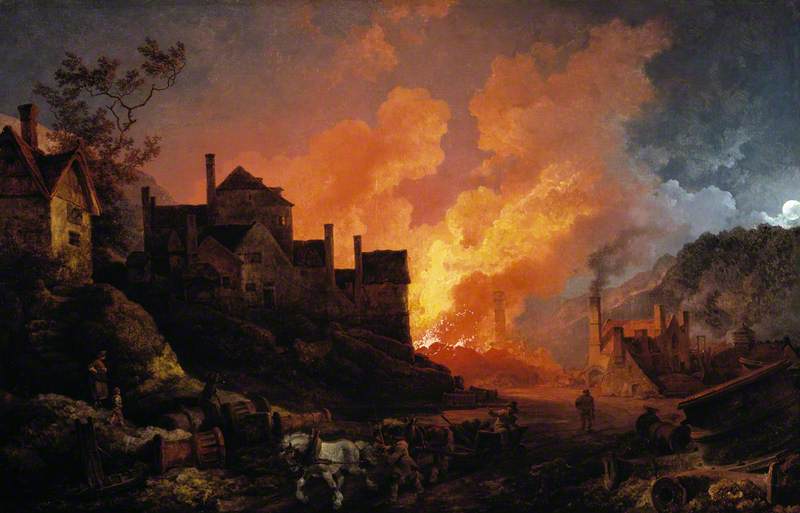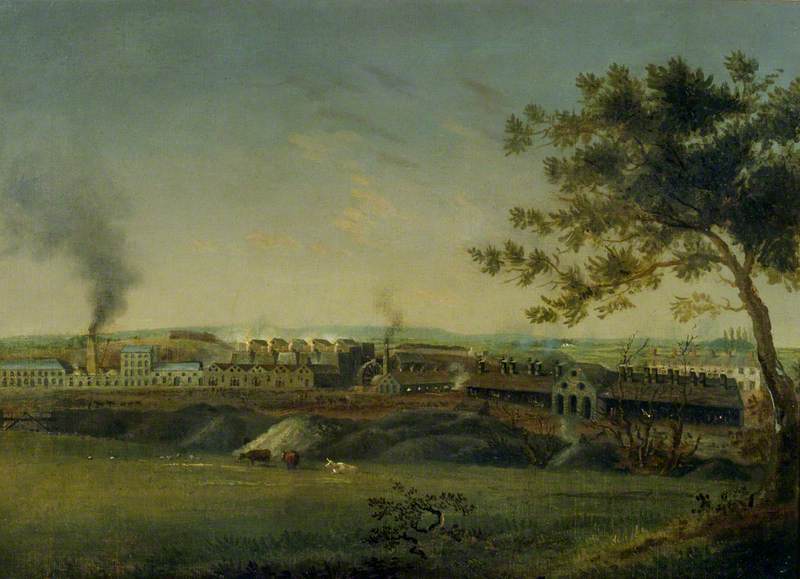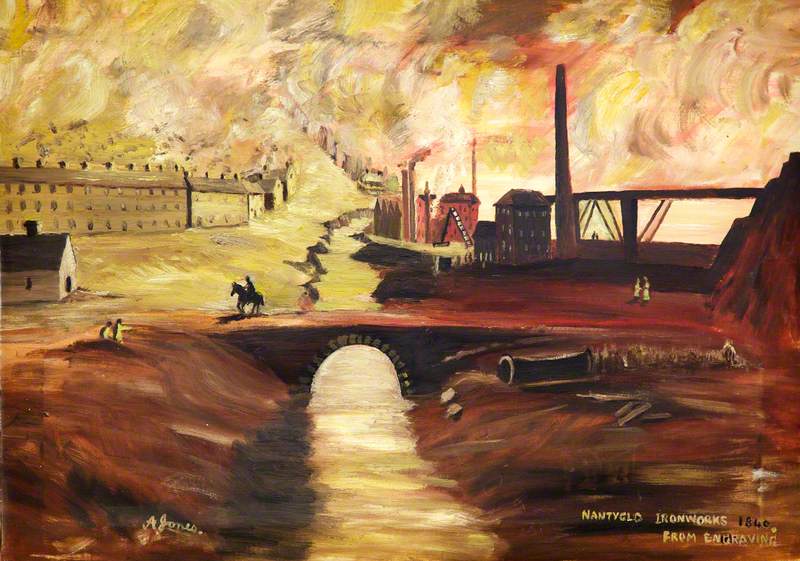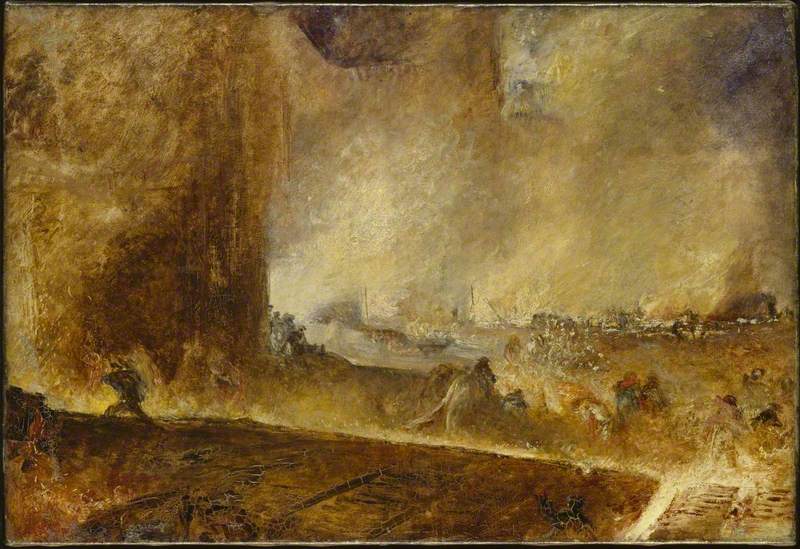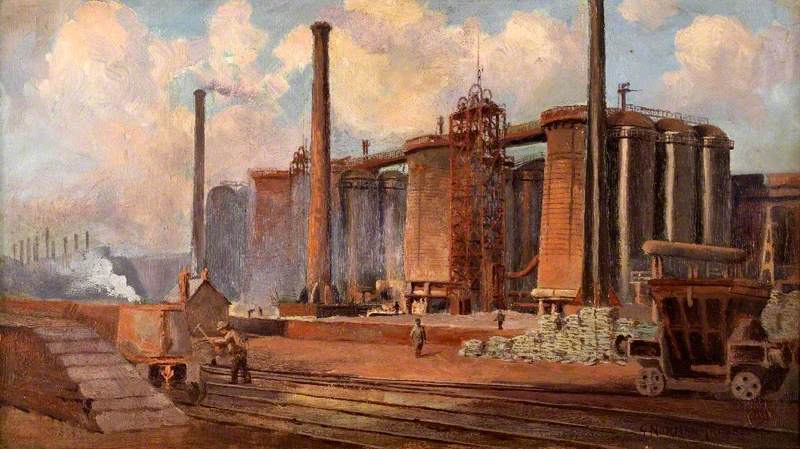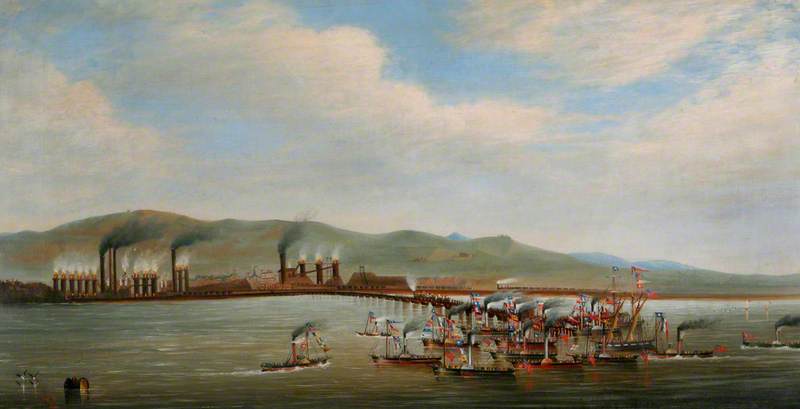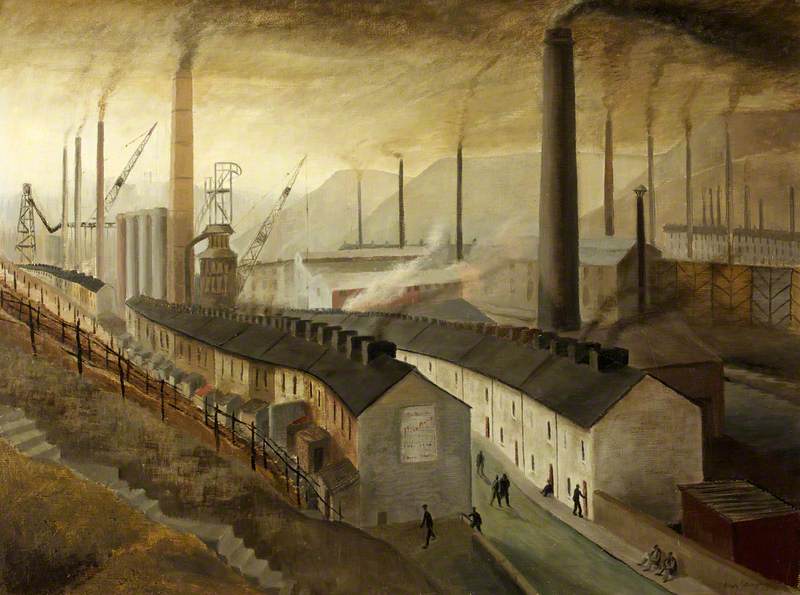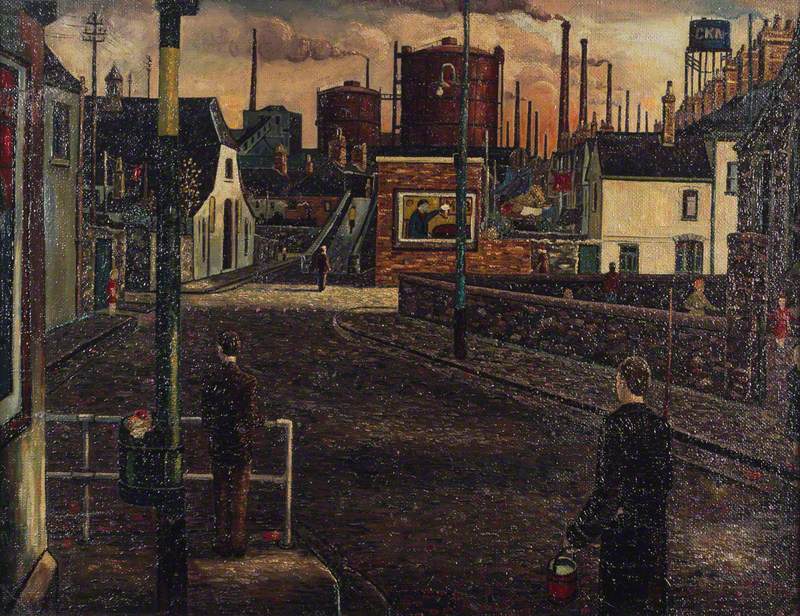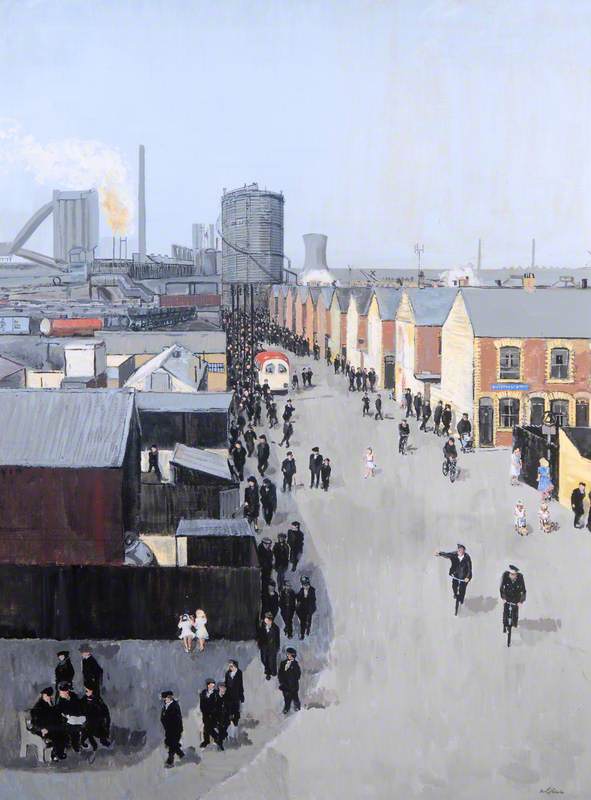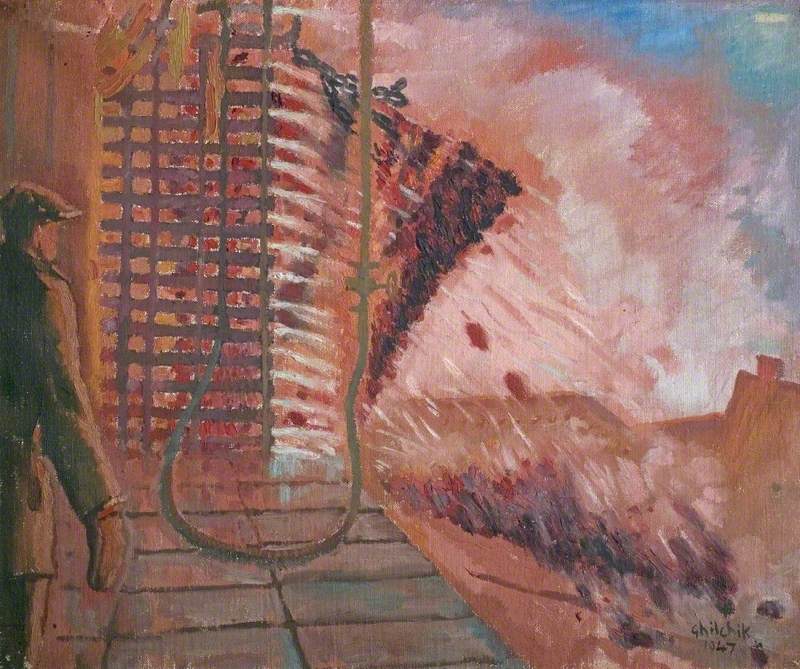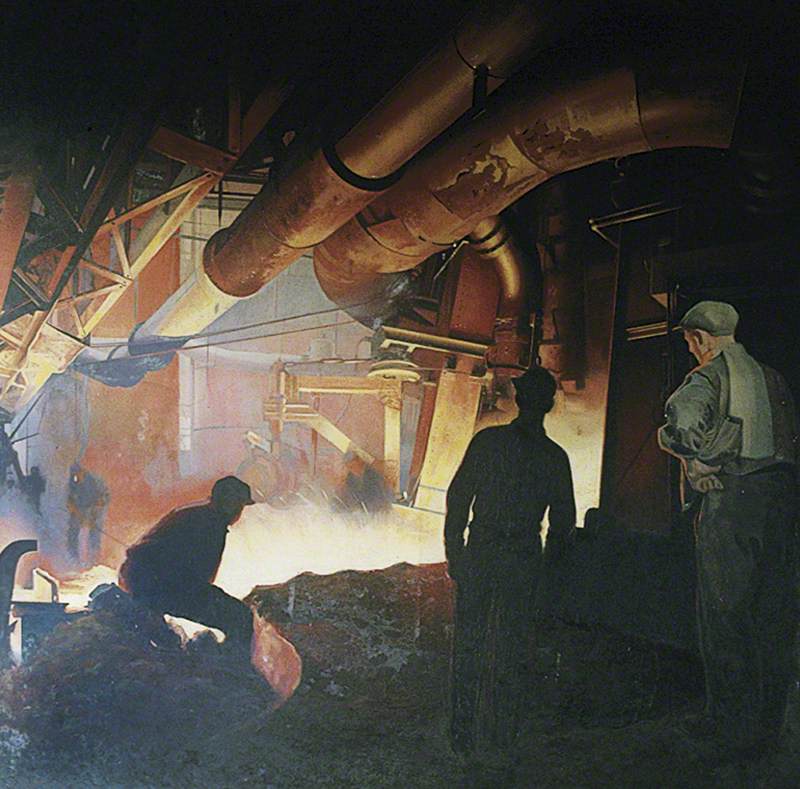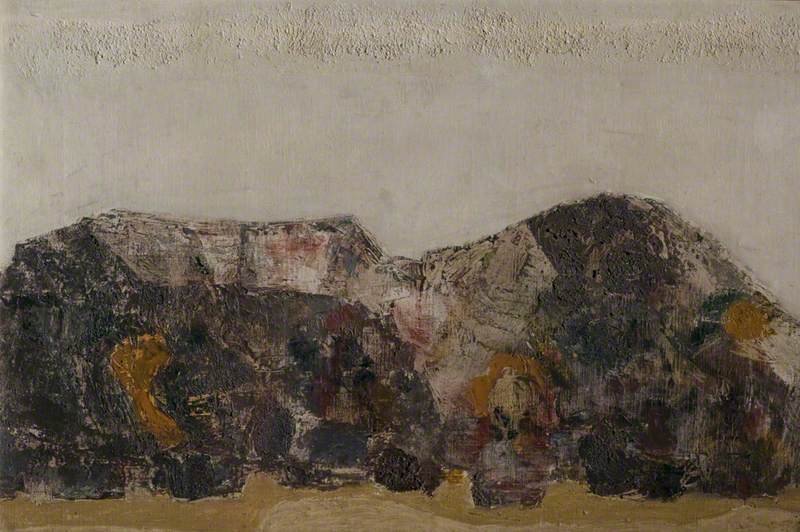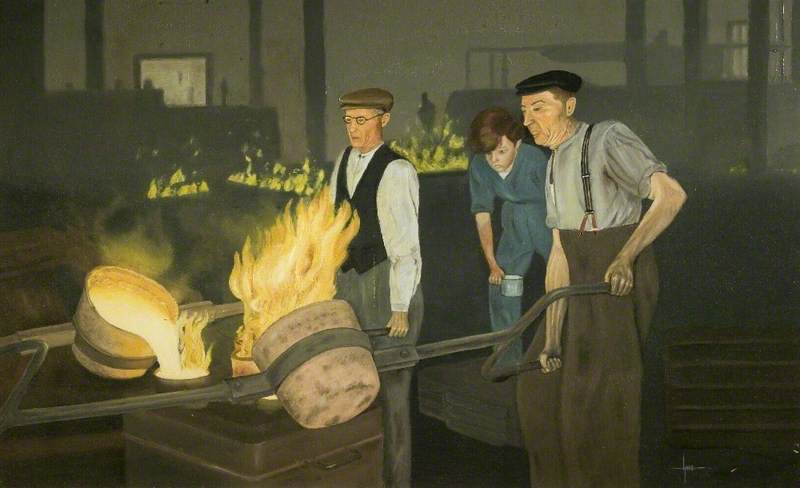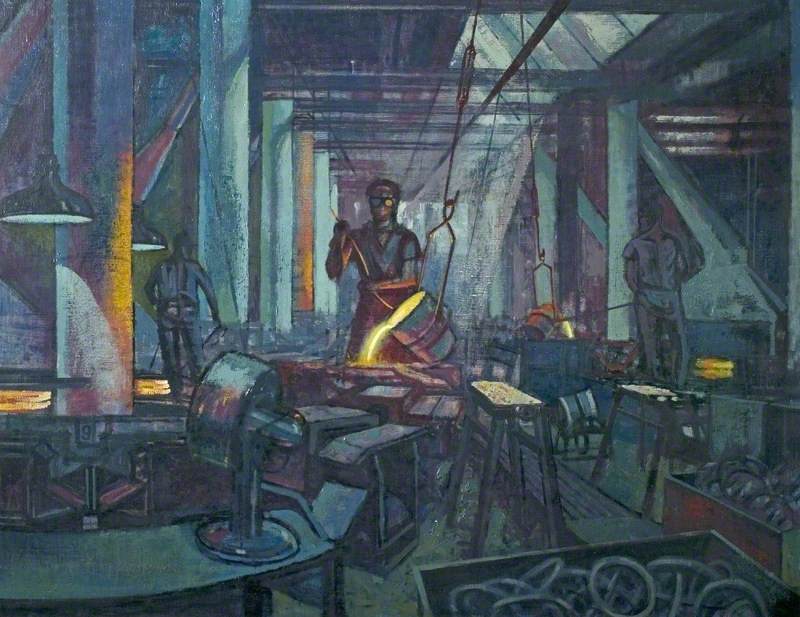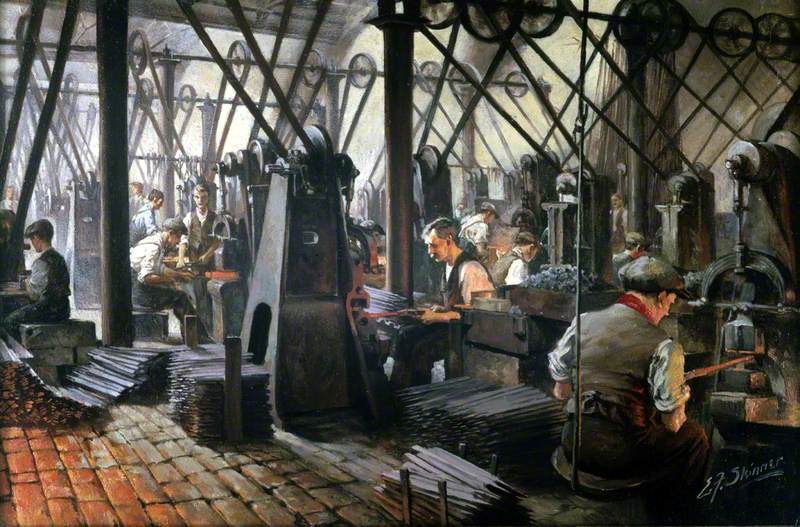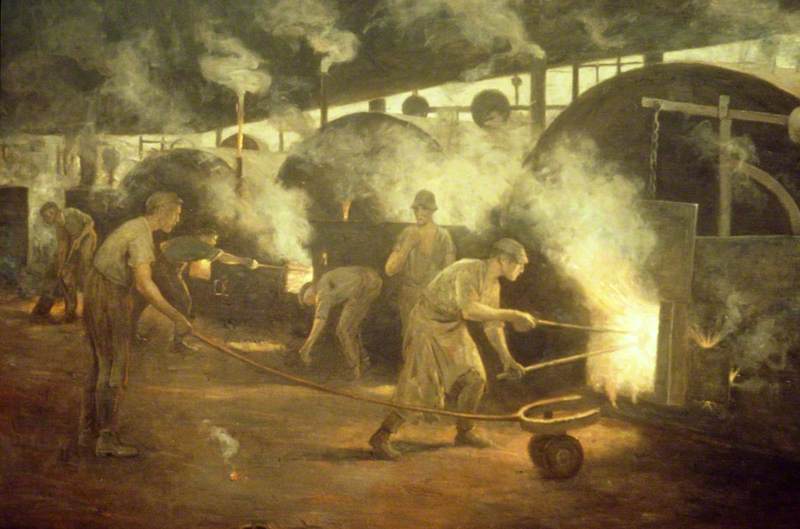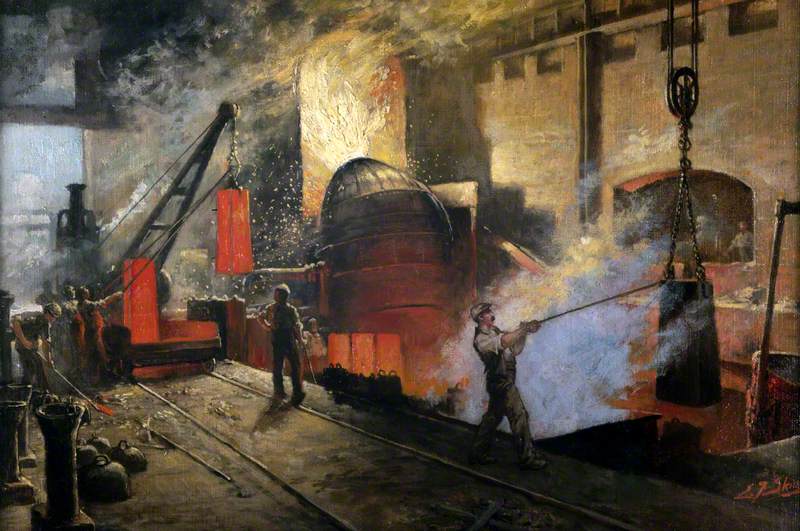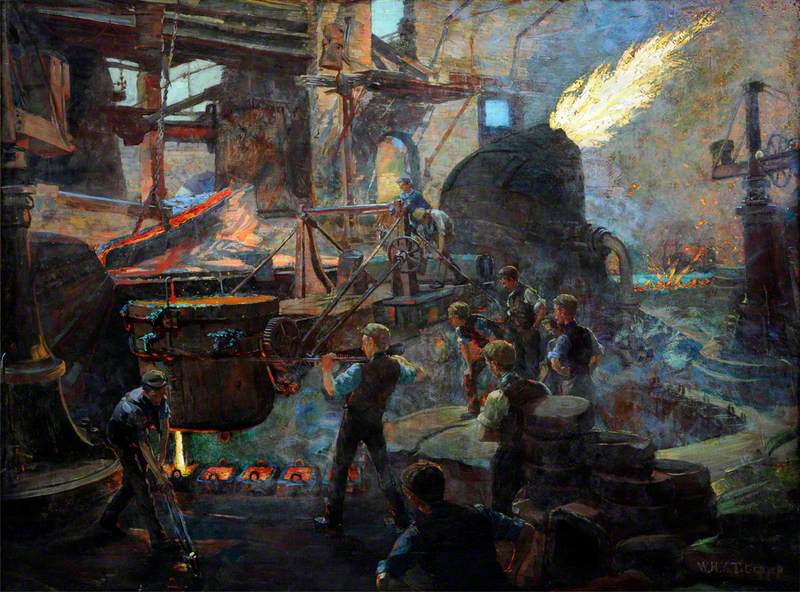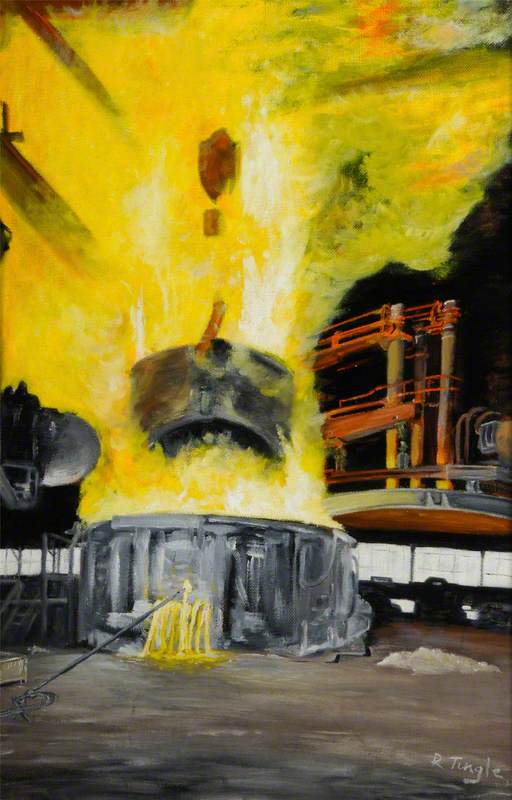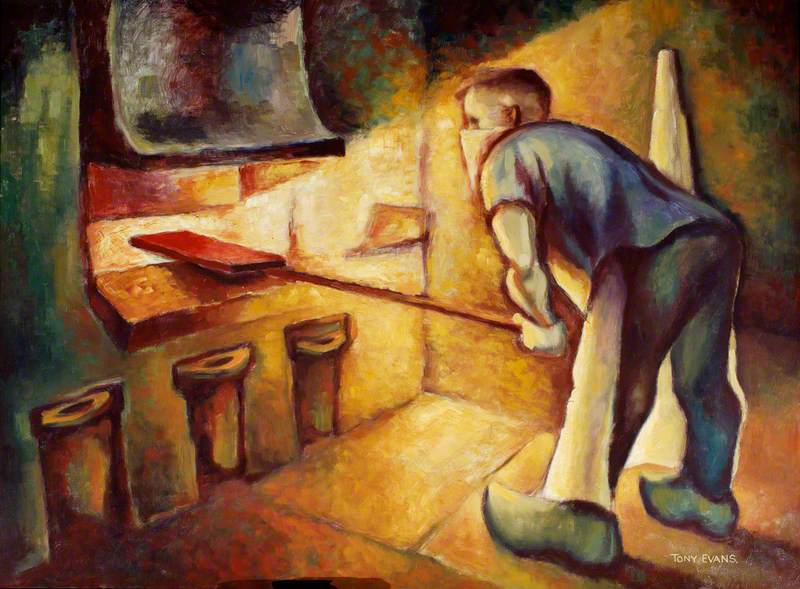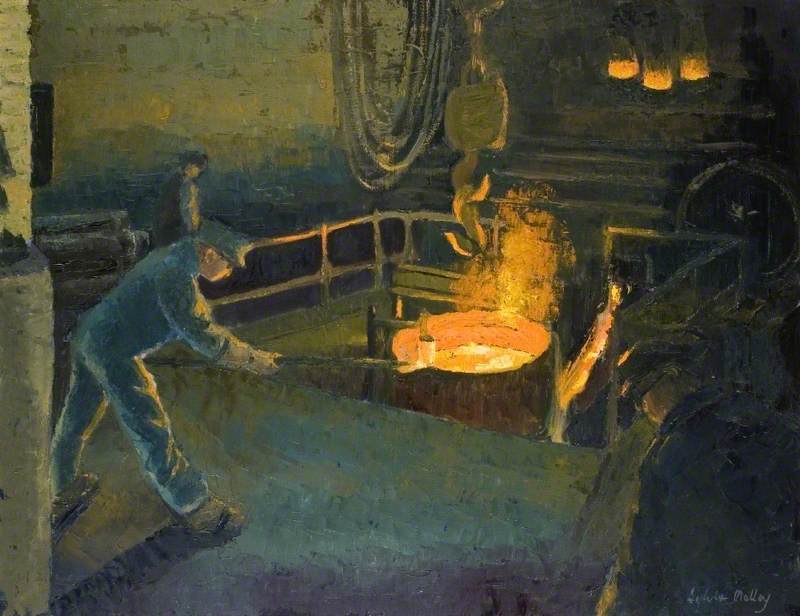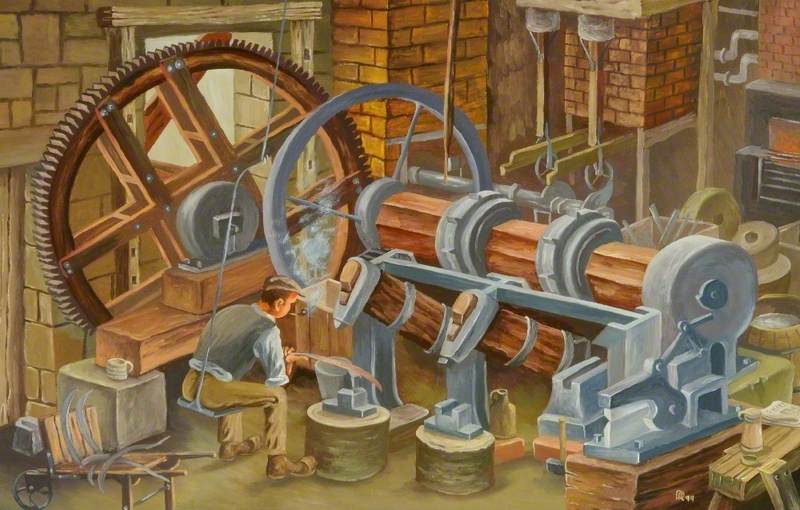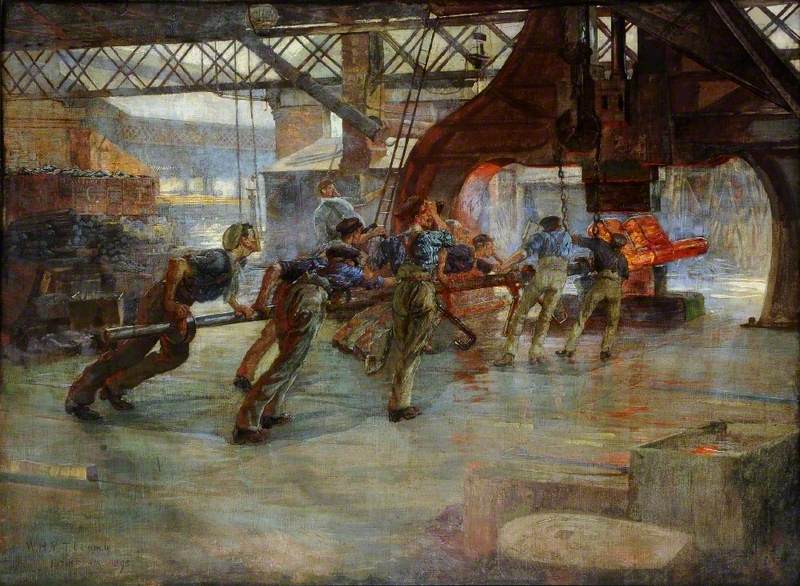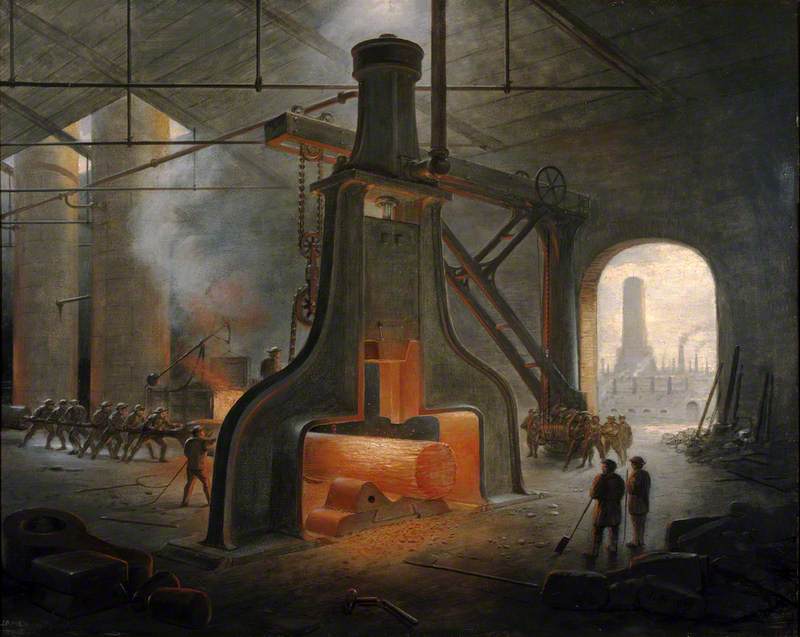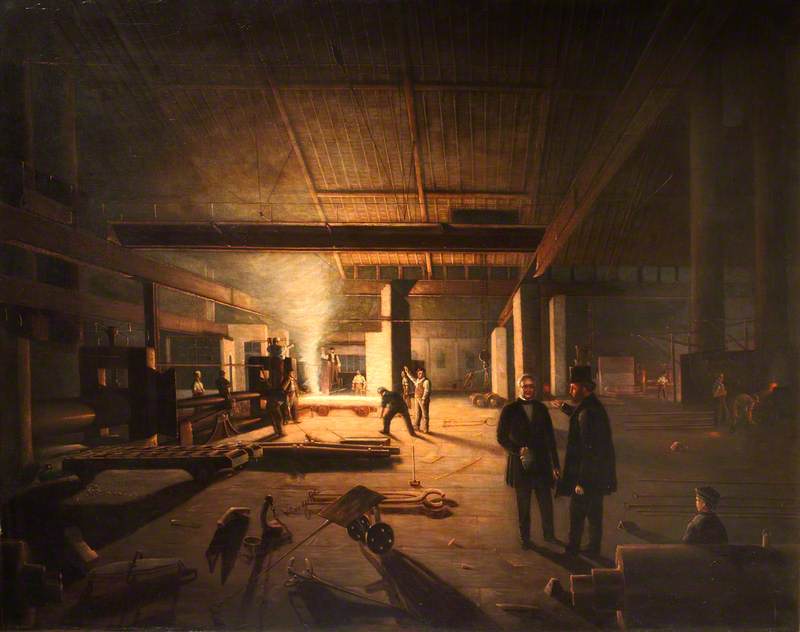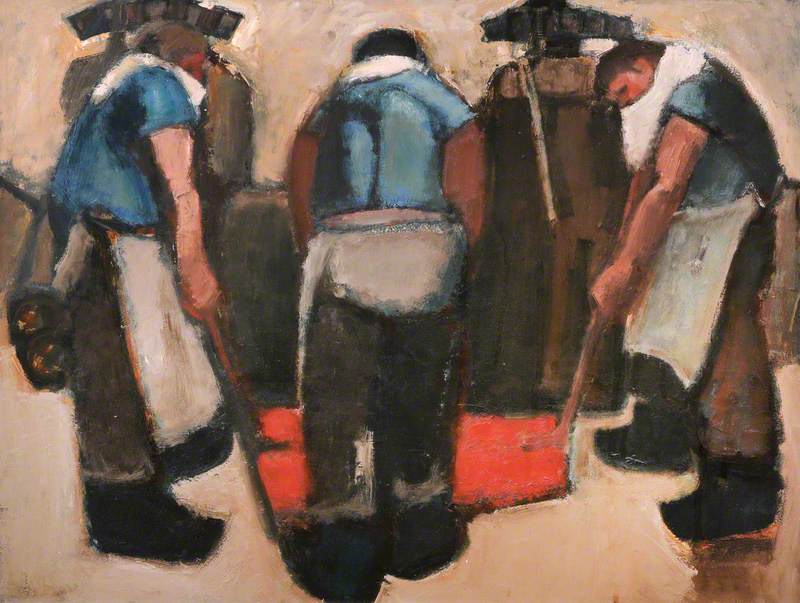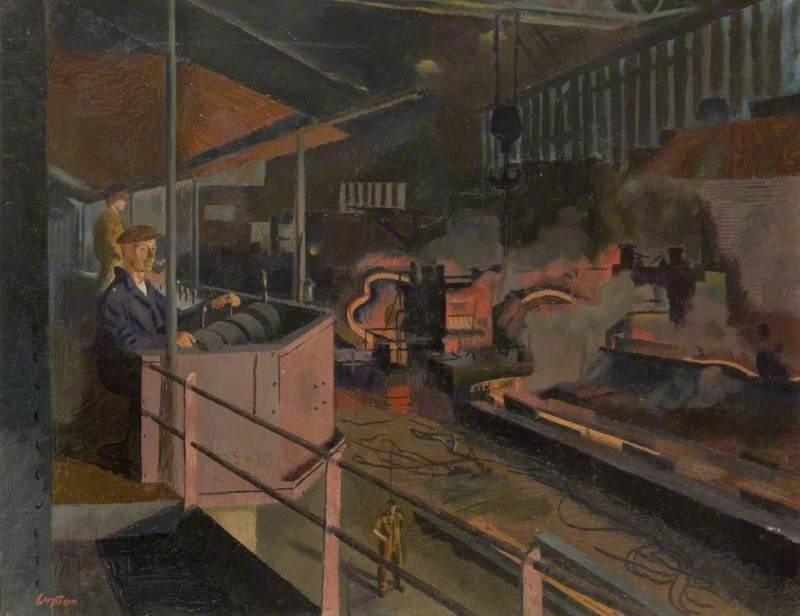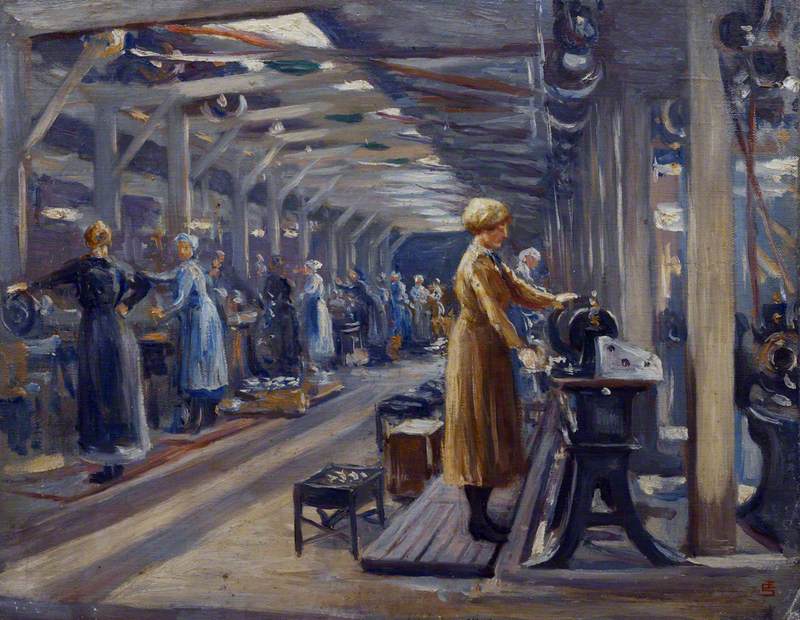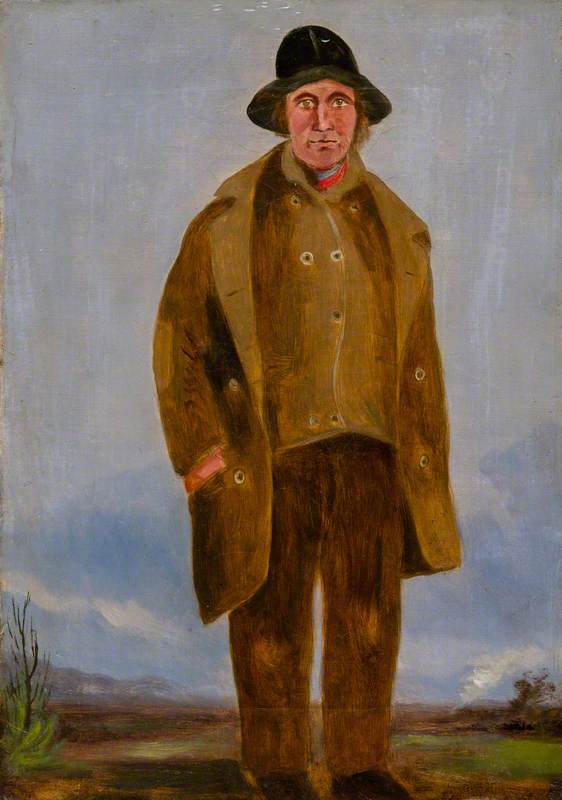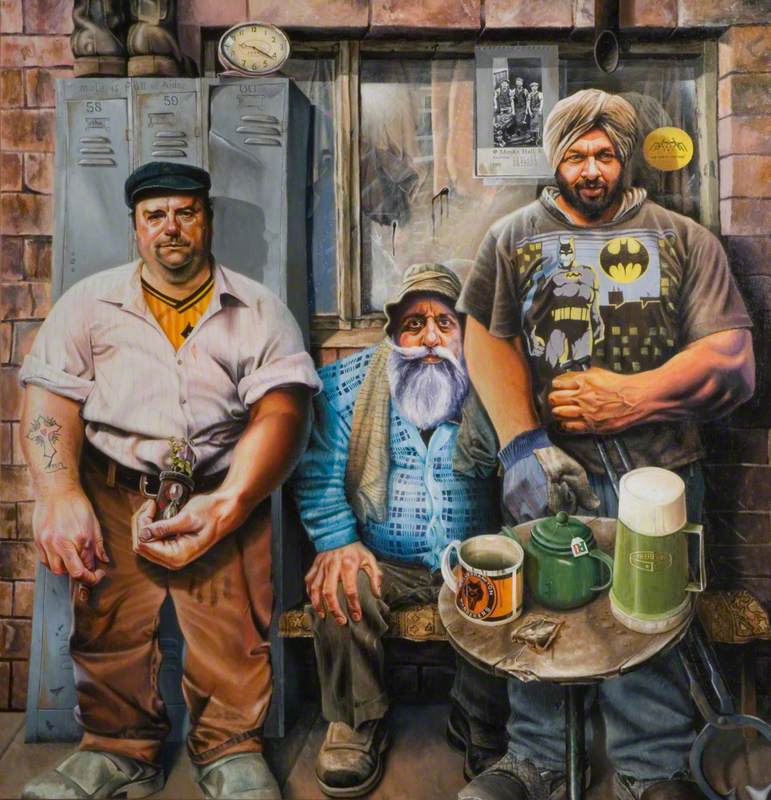An iron and steel works, with its subsidiary workshops, is indeed the paradise of the modern artist. From Bolckow and Vaughan and Co, (1928) A Romance of Industry: London.
I first started to think about connections between art and the steel industry in 2014 when at an exhibition of coalmining art at the Bowes Museum in Barnard Castle. The paintings, sculptures and banners on display led me to wondering whether artists had shown similar interest in recording iron and steel production. This ArtUK site, or BBC Your Paintings as it was at the time, was the first step in helping me to find out.
-
Afternoon View of Coalbrookdale, Shropshire
Afternoon View of Coalbrookdale, Shropshire 1777In the view of most historians, mass production of iron began in Coalbrookdale. This painting is one of the earliest depictions of the impact of the industrial revolution on pastoral landscapes. The smoke and grime down in the valley afford a sharp contrast to the rural idyll of the hillside, where the women, in their white dresses, are seemingly enjoying a country stroll. I guess they would soon learn that white is not an appropriate colour for wearing in such a place; although in this case the artist has been kind enough to have the furnace smoke blowing away from the ramblers.
William Williams of Norwich (1727–1797)
Oil on canvas
H 100 x W 123.7 cm
Shrewsbury Museum and Art Gallery
-
Coalbrookdale by Night
Coalbrookdale by Night 1801At the dawn of the 19th century, Philip de Loutherbourg evoked a more dramatic vision of beautiful dale in his painting of Coalbrookdale at Night, in which he contrasts a terrifying inferno at the ironworks with images of traditional rural activity.
Philip James de Loutherbourg (1740–1812)
Oil on canvas
H 68 x W 107 cm
Science Museum
-
Crawshay's Cyfarthfa Ironworks
Crawshay's Cyfarthfa Ironworks 1817The Crawshay family were, arguably, the most important ironmasters in South Wales. Richard Crawshay took ownersip of Cyfarthfa works in 1791. It was his grandson William, however, who commissioned Penry Williams, a well-known landscape painter of the time, to do some paintings of the work. This one is apparently of the view from the Crawshay family mansion. It provides a broad view of the industrial landscape which displays the great extent of the patron’s ironworks but, with the rising steam and smoke, manages to draw some attention to the potential damage from the industry to the local environment. The Cyfarthfa works closed in 1910, re-opened during World War 1 to help with the war effort, and closed permanently in 1919.
Penry Williams (1802–1885)
Oil on canvas
H 51 x W 71 cm
Amgueddfa Cymru – National Museum Wales
-
Dowlais Iron Works
Dowlais Iron Works c.1825The Dowlais works, was established in 1759 alongside the River Taff near Merthyr Tydfil, South Wales. By 1815 it was the largest iron producer in the world, and by the mid 19th century employed more than seven thousand people at its eighteen furnaces, including my great-grandfathers Charles McCarthy and William Hartnett who arrived in South Wales seeking a better life than they had in a famine ravished Ireland. The company continued prosperity due to its early engagement in steel production. Its first output of Bessemer steel was rolled at the works in 1865. The plant ultimately closed in the 1930s.
Penry Williams (1802–1885)
Oil on canvas
H 55 x W 99 cm
Llyfrgell Genedlaethol Cymru / The National Library of Wales
-
Nantyglo Ironworks, 1840
Nantyglo Ironworks, 1840The Nantyglo Ironworks were built between 1792 and 1794 by Thomas Hill of Blaenavon. The works had period of success, especially during high demand for its wrought iron rails during the railway expansion of 1830s and 1840s The works closed in 1871, though, which means it never engaged in steelmaking.
Arthur Jones
Acrylic on canvas
H 52.3 x W 74.3 cm
Abertillery & District Museum
-
Iron Works, Middlesbrough
Iron Works, Middlesbrough c.1865–70Iron production arrived in Middlesbrough in the 1850s following discovery of large deposits of iron ore in the nearby Eston Hills. Middlesbrough was in a perfect situation: there was iron ore close by, plentiful coal in the nearby Durham coalfield, and access to harbour facilities on the River Tees. By 1867 there were 47 blast furnaces lining the river bank, and Middlesbrough itself had changed from a hamlet to a considerable town. During the last half of the 19th century its population grew from 7,431 people to 91,302. It was very much an immigrant town with residents drawn from all parts of the British Isles, especially from Ireland: including my great-grandparents who made the trek up from South Wales in the 1870s.
Alfred William Hunt (1830–1896)
Oil on canvas
H 43.8 x W 64.1 cm
Tate
-
Ayresome Ironworks, Middlesbrough, Tees Valley
Ayresome Ironworks, Middlesbrough, Tees ValleyAyresome Iron Works was established in 1870 on the south bank of the River Tees, and closed in the 1960s.
George Norman-Crosse (c.1871–1912)
Oil on canvas
H 35.5 x W 57.7 cm
Beamish, The North of England Open Air Museum
-
The Visit of Mr W. E. Gladstone to Middlesbrough
The Visit of Mr W. E. Gladstone to Middlesbrough 1862The painting commemorates an 1862 visit to the burgeoning industrial metropolis alongside the River Tees by William Gladstone – sometimes Prime Minister but Chancellor of the Exchequer at the time. During this visit he referred to Middlesbrough as, "This remarkable place, the youngest child of England's enterprise. It is an infant, gentlemen, but it is an Infant Hercules."
W. T.
Oil on canvas
H 39.5 x W 75 cm
Redcar and Cleveland Council
-
Steelworks, Ebbw Vale
Steelworks, Ebbw ValeAs the iron and steel industry grew, the housing of the workforce became a major concern. In most places, the ironmasters had little choice but to provide it themselves, as there were rarely settlements of any consequence nearby. Eventually, sizeable townships grew around the furnaces, mills, and factories. Initially the ironmasters themselves tended to live near the works, but their descendants generally moved away and spent their family fortunes on land, building mansions and enjoying the trappings of country life. For the workers and their families, however, housing conditions were generally grim.
Nan Youngman (1906–1995)
Oil on board
H 59.7 x W 80 cm
Newport Museum and Art Gallery
-
Steel Works, Adamsdown
Steel Works, AdamsdownLooks like morning, with men heading to the steelworks for the morning shift. In one sense it was handy being so close to the works. However, such proximity to the pollution was not healthy for the workers and their families.
Charles Byrd (1916–2018)
Oil on canvas
H 74 x W 96 cm
Cardiff Council
-
Cheetham Street, Middlesbrough, Tees Valley
Cheetham Street, Middlesbrough, Tees Valley 1953This painting depicts the streets of Grangetown, near Middlesbrough, in which I grew up. I was living there at the time that the painting was done: I was ten at the time. The houses are the original eight streets of Grangetown, built in the 1880s to house workers employed at the Bolckow and Vaughan steelworks. The eight streets were demolished in the late sixties; to make way for the A66 from Middlesbrough to Redcar and the Bolckow industrial estate. When painting this picture, the artist would have been looking down from the Lyric Cinema, where I spent every Saturday afternoon.
Kenneth Gribble (1925–1995)
Oil on canvas
H 100 x W 74.5 cm
Middlesbrough Institute of Modern Art, mima
-
Beehive Coke Ovens
Beehive Coke OvensCoke was the fuel for the furnaces in which ironstone was smelted. It is made by baking coal in ovens. The process for mass production of it was developed by Abraham Darby of Coalbrookdale. Before that, iron furnaces had used charcoal which was made by burning wood and its use in iron-making had led to considerable deforestation. Without Darby's invention mass production of iron would have not have been possible. The beehive shaped ovens were common in the late 19th century,
Herbert Cooper (1911–1979)
Oil on board
H 35.7 x W 50.5 cm
Beamish, The North of England Open Air Museum
-
Coke Ovens, Cargo Fleet
Coke Ovens, Cargo Fleet 1955A more modern steel-made versions of a battery of coke ovens at Cargo Fleet Works in Middlesbrough. Cargo Fleet, opened in 1905, was the first fully-integrated purpose-built steelworks in the North of England. I served an apprenticeship there as a Fitter and Turner (1959-64).
Kenneth Cozens (1920–2000)
Oil on canvas
H 49.5 x W 60 cm
Middlesbrough Institute of Modern Art, mima
-
Quenching Coke When Ejected from the Ovens
Quenching Coke When Ejected from the Ovens 1947Coke is currently made in batches of ovens with doors at the front and back. Coal is loaded from one end; and both doors are closed while the coal is alight, thus depriving the coal of air so that it baked rather than burned. When the coke is ready, the front doors are opened and the the red-hot coke is pushed out into a truck by a ram, and quenched under cooling towers. This painting shows the coke being pushed out, and quenched; while a coke-oven worker stands by.
David Ghilchik (1890–1970)
Oil on canvas
H 58.3 x W 68.2 cm
Chesterfield Museum & Art Gallery
-
Study for Blast Furnace
Study for Blast Furnace 1977Modern blast furnaces are tall metal structures lined with refractory brick. They have grown significantly in size and have become much more efficient, but the principles of iron production have changed little. Coke, limestone, flux, and iron ore are charged into the top of the furnace and a hot blast of air is blown into the lower section so that chemical reactions take place throughout the furnace as the material moves downward. The resulting molten metal is tapped from the bottom of the furnace, as is the slag that has been separated from it, while flue gases are drawn from the top.
Harry Norman Eccleston (1923–2010)
Oil on paper
H 67 x W 48.7 cm
The Black Country Living Museum
-
Tapping a Blast Furnace
Tapping a Blast Furnace 1957
Charles William Brown (1882–1961)
Oil on board
H 60 x W 60 cm
The Potteries Museum & Art Gallery
-
Blast Furnace Scene
Blast Furnace SceneBlast-furnace workers standing by. Looking at the glow and waiting for the tapping.
Laurence John C. Houghton (1913–1988)
Oil on canvas
H 151 x W 151 cm
Armley Mills, Leeds Industrial Museum
-
Tipping the Slag
Tipping the SlagWhen furnaces were tapped, a waste product known as slag was drawn off separately. It was tapped into ladles and dumped some distance away while still molten. One of the results of this was the appearance of large slag heaps close to where the workers and their families live. They were not a pretty sight, and in some cases dangerous. Over time, however, dumping of slag was greatly reduced by using slag in road building and ballast as well as ingredients of cement and fertilisers.
Edwin Butler Bayliss (1874–1950)
Oil on canvas
H 61 x W 92 cm
Wolverhampton Arts and Heritage
-
Slag Heap
Slag Heap 1959
Prunella Clough (1919–1999)
Oil on canvas
H 30.5 x W 46 cm
Leicester Museums and Galleries
-
Chapel and Slag Heap
Chapel and Slag Heap c.1970
George Chapman (1908–1993)
Oil on board
H 29 x W 49 cm
Llyfrgell Genedlaethol Cymru / The National Library of Wales
-
Ley Maleable Works, Lincoln
Ley Maleable Works, Lincoln 1920Pig iron produced by smelting iron ore in furnaces was initially used to produce cast iron products in foundries. This involved reheating the iron until molten again and then pouring it into moulds. The main products from this process were originally items such as pots, pans, and cannon balls. Eventually. it began to be used for structural purposes. Abraham Darby constructed the first cast-iron bridge at Coalbrookdale, Shropshire, in the 1770s, It is still standing.
L. Hare
Oil on board
H 46 x W 75 cm
Museum of Lincolnshire Life
-
The First Iron Bridge, Shropshire
The First Iron Bridge, ShropshireConstructed in the 1770s
Anthony John Plowden Eyton (b.1923)
Oil on canvas
H 42 x W 49.5 cm
National Trust, Sunnycroft
 © the artist / Bridgeman Images. Photo credit: National Trust Images
© the artist / Bridgeman Images. Photo credit: National Trust Images
-
Foundry Scene
Foundry Scene c.1930–1940
unknown artist
Oil on canvas
H 71 x W 92 cm
Derby Museums
-
The Little Forge, Lyme Regis
The Little Forge, Lyme Regis 1895
James Abbott McNeill Whistler (1834–1903)
Oil on panel
H 13.6 x W 23.4 cm
The Hunterian, University of Glasgow
-
Forging Files
Forging Files 1918
Edward Frederick Skinner (1865–1924)
Oil on board
H 31 x W 47 cm
Science Museum
-
Puddlers at a Staffordshire Puddlers Workshop
Puddlers at a Staffordshire Puddlers WorkshopAfter 1784, wrought iron tended to be produced in puddling furnaces, which were developed by Henry Cort. In the puddling furnace molten iron was stirred by a puddler until semi-solid bits of iron appeared in the liquid mass. The puddler would then gather these into a single mass, remove them from the furnace and work them under a forge hammer. Only men of remarkable strength and endurance could stand up to the heat for hours, turn and stir the thick porridge of liquescent metal, and draw off the blobs of pasty wrought iron. Thus, the puddlers were the aristocracy of the industry but few of them lived past forty, and many of them went blind well before that.
Percy Currall Pace (1871–1945)
Acrylic on board
H 115 x W 200 cm
Amgueddfa Cymru – National Museum Wales
-
Making Bessemer Steel
Making Bessemer Steel 1917Although wrought iron was more useful than cast iron it was eventually replaced by steel, which is harder than wrought iron and not as brittle as cast iron. Steel had been difficult and expensive to manufacture until Henry Bessemer invented his converter in the mid-18th century. The Bessemer converter was a large, pear-shaped receptacle with holes at the bottom that allowed the injection of compressed air. Steel was produced in the converter by blowing compressed air through molten pig iron, thus reducing its carbon and silicon content.
Edward Frederick Skinner (1865–1924)
Oil on canvas
H 31 x W 47 cm
Science Museum
-
The Wealth of England, the Bessemer Process of Making Steel
The Wealth of England, the Bessemer Process of Making Steel 1895The original converter was not effective in removing the phosphorus present in most British and European iron ore. When Bolckow and Vaughan, in Middlesbrough, turned to steel production, they were dependent on imported iron ore with a low phosphorous content. However, Sidney Gilchrist Thomas discovered that lining a converter with a basic material such as burned limestone overcame this problem, which meant that Bolckow and Vaughan could take advantage of the abundant supply of high-phosphorous ore in the nearby Eston Hills. The company grew rapidly from this point to become the largest steel producer in Britain, and possibly the world. In 1905, the firm produced 820,000 tons of pig iron – 8.5% of Great Britain's output, and twice as much as
William Holt Yates Titcomb (1858–1930)
Oil on canvas
H 114.5 x W 152.7 cm
Sheffield Industrial Museums Trust
-
Furnace/Smelting at a Steelworks
Furnace/Smelting at a Steelworks
Charles Ernest Cundall (1890–1971)
Oil on board
H 60 x W 49 cm
Amgueddfa Cymru – National Museum Wales
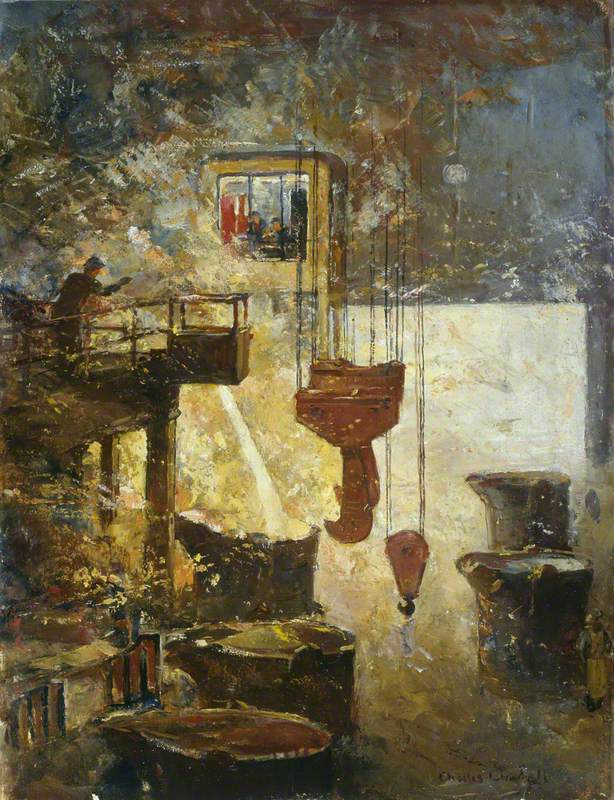 © the artist's estate / Bridgeman Images. Photo credit: Amgueddfa Cymru – National Museum Wales
© the artist's estate / Bridgeman Images. Photo credit: Amgueddfa Cymru – National Museum Wales
-
Feeding a Steel Furnace
Feeding a Steel Furnace 1941–2Bessemer furnaces were eventually replaced by a process which converted iron into steel in a broad, shallow, gas-fired, open-hearth furnaces. fuelled by adding wrought iron, or iron oxide, to molten pig iron until reducing the carbon content through dilution and oxidation. Unlike the Bessemer converter, which makes steel in one volcanic rush, the open-hearth process takes hours and allows for periodic laboratory testing of the molten steel so that steel can be made to precise specifications.
Graham Vivian Sutherland (1903–1980)
Oil on canvas
H 90.2 x W 86.4 cm
Tate
-
Bessemer Process Plant, Abbey Works, Margam
Bessemer Process Plant, Abbey Works, Margam c.1958The Bessemer process facilitated large-scale steel production and virtually changed the world. Steel production became the most important industry on the planet, as steel became used in the creation of everything from bridges to railways to skyscrapers to engines to ships to motor cars and to armaments. Such was its importance that many historians described the introduction of the Bessemer process as the launch of the second industrial revolution.
Charles Ernest Cundall (1890–1971)
Oil on canvas
H 84 x W 64.8 cm
Amgueddfa Cymru – National Museum Wales
 © the artist's estate / Bridgeman Images. Photo credit: Amgueddfa Cymru – National Museum Wales
© the artist's estate / Bridgeman Images. Photo credit: Amgueddfa Cymru – National Museum Wales
-
Feeding the Furnace
Feeding the FurnaceThe electric arc furnace is loaded with cold scrap steel, which is melted by an electric current. The basic oxygen process uses a vessel charged with scrap and molten iron and high purity oxygen is blown into the furnace through a water-cooled lance. The oxygen combines with the carbon in the iron to remove impurities.
John William Howey (1873–1938)
Oil on canvas
H 65 x W 63 cm
Hartlepool Museums and Heritage Service
-
Tinsley Park, Sheffield, Electric Arc Furnace Receiving a Charge of Scrap
Tinsley Park, Sheffield, Electric Arc Furnace Receiving a Charge of ScrapThe open-hearth process also allows for production of larger batches of steel than the Bessemer process does, and for the recycling of scrap metal. Consequently, the open-hearth process virtually replaced the Bessemer furnaces until the 1960s, when electric-arc furnaces and basic oxygen furnaces replaced it.
Roy Tingle
Oil on board
H 92 x W 62 cm
Sheffield Industrial Museums Trust
-
The Furnace Man
The Furnace Man c.1940–1944
Stanley Spencer (1891–1959)
Oil on hardboard
H 37 x W 25 cm
Worthing Museum and Art Gallery
 © the estate of Stanley Spencer. All rights reserved / Bridgeman Images. Photo credit: Worthing Museum and Art Gallery
© the estate of Stanley Spencer. All rights reserved / Bridgeman Images. Photo credit: Worthing Museum and Art Gallery
-
The Furnace Man
The Furnace Man c.1988
Tony Evans (1920–2001)
Oil on board
H 75.7 x W 101.3 cm
Carmarthenshire Museums Service Collection
-
Testing for Steel, Kryn and Lahy Steel Founders and Engineers Ltd, Letchworth
Testing for Steel, Kryn and Lahy Steel Founders and Engineers Ltd, Letchworth
Sylvia Molloy (1914–2008)
Oil on canvas
H 71 x W 92 cm
Garden City Collection
-
Tilt Hammer, 1930
Tilt Hammer, 1930 2000Blast furnaces produce iron and the Bessemer, open-hearth and BOS furnaces turn it into steel. Both products take on use-value when shaped into products – plates, rods, beams, rails etc. – via hammering or rolling. The demand for increasingly bigger products necessitated more technological innovation. Hammering machines with heavy heads at the end of a pivotal lever – such as the one shown below – came into use in the mid-18th century. These machines (tilt hammers) were initially water driven.
Robert Penistone (b.1946)
Oil on board
H 43 x W 63 cm
Sheffield Industrial Museums Trust
-
The Steam Hammer
The Steam Hammer 1895After learning, in 1838, that the Great Western Steam Company was experiencing problems forging the paddle shaft of the SS Great Britain, James Nasmyth invented a steam-driven hammer, it seems that even when the largest tilt hammer was tilted to its full height its range was so small that if a large piece of work was placed on the anvil, the hammer had no room to fall. Nasmyth solved this problem and prompted someone to compose this little ditty about him.
Scotsman Nasmyth was said,
To have hammers inside of his head,
While others laughed,
He forged a great shaft,
By pounding it while it was red.
William Holt Yates Titcomb (1858–1930)
Oil on canvas
H 110 x W 148 cm
Sheffield Industrial Museums Trust
-
A Steam Hammer at Work
A Steam Hammer at Work 1871This painting of a steam hammer is of particular interest in that it is credited to James Nasmyth. its inventor. James' father was Alexander Nasmyth, a renowned landscape and portrait painter. When a a young man, James planned to follow in his father’s footsteps and studied at the Edinburgh School of Art. After inventing the steam hammer, he retired from business and spent the final thirty years of his life painting and studying astronomy; which was apparently his major passion.
James Nasmyth (1808–1890)
Oil on board
H 40 x W 50 cm
Science Museum
-
Interior of a Rolling Mill
Interior of a Rolling Mill 1855–1865Rolling mills consist of banks of rolling machines that turn ingots of steel into products such as beams, rods, sheets, and rails. Leonardo de Vinci is often credited with the concept of rolling metal, but it is generally thought that Henry Cort pioneered its industrial practice, in 1783. With his design, mills were able to produce fifteen times more output per day than could be achieved by working steel under a hammer. Subsequent technological advancement has enabled the size of the mills to grow rapidly over time, and to increase the size and range of products being rolled.
Godfrey Sykes (1824–1866)
Oil on canvas
H 100 x W 125 cm
Science Museum
-
The Rolling Mill
The Rolling Mill c.1904/1905
Frank Brangwyn (1867–1956)
Oil on canvas
H 165.1 x W 541 cm
Leeds Museums and Galleries
 © the artist's estate / Bridgeman Images. Photo credit: Leeds Museums and Galleries
© the artist's estate / Bridgeman Images. Photo credit: Leeds Museums and Galleries
-
Hand Rolling Mill (Steel), South Wales
Hand Rolling Mill (Steel), South Wales
Will Roberts (1907–2000)
Oil on hardboard
H 64 x W 74.5 cm
Bangor University
-
Hot Strip Mill
Hot Strip Mill c.1952
Norman Hepple (1908–1994)
Oil on canvas
H 75.5 x W 63 cm
Ebbw Vale Works Archival Trust
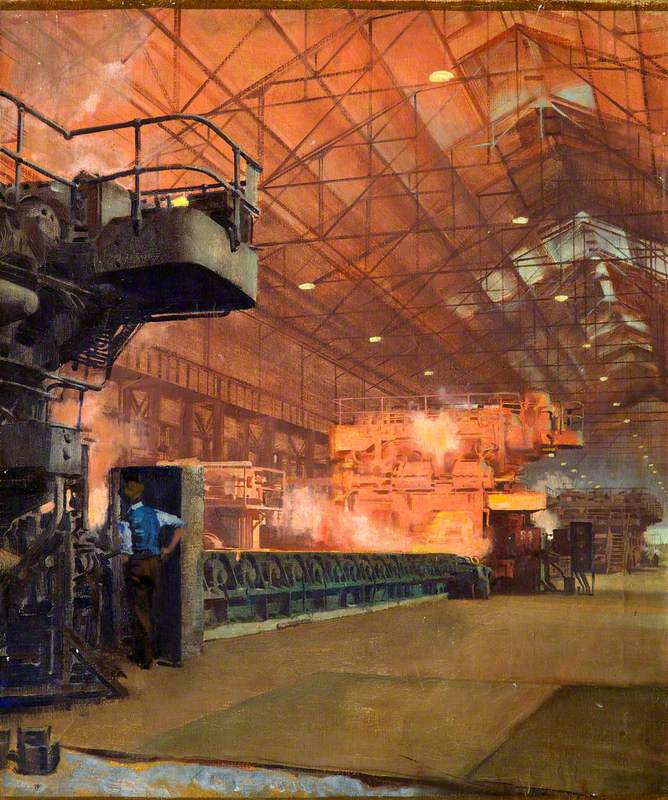 © the artist's estate / Bridgeman Images. Photo credit: Ebbw Vale Works Archival Trust
© the artist's estate / Bridgeman Images. Photo credit: Ebbw Vale Works Archival Trust
-
Rolling Mills, Corby Steelworks
Rolling Mills, Corby Steelworks
Horace Copson (1903–1980)
Oil on board
H 69 x W 90 cm
North Northamptonshire Council
-
The Munition Girls, 1918
The Munition Girls, 1918 1918During the two world wars of the 20th century steelworks and munitions production were kept going by women workers. Most of whom lost their jobs when the war was over.
Stanhope Alexander Forbes (1857–1947)
Oil on canvas
H 103 x W 127 cm
Science Museum
-
Women at Work: The Belgian Steel Factory, Goldhawk Road, W12
Women at Work: The Belgian Steel Factory, Goldhawk Road, W12 1918
Edgar Seligman (1867–1958)
Oil on panel
H 34.2 x W 44.4 cm
IWM (Imperial War Museums)
-
An Unknown Crawshay Employee
An Unknown Crawshay Employee c.1835–1840This is one of sixteen portraits of workers commissioned in the late 1830s by Francis Crawshay, the grandson of William Crawshay the founder of the Crawshay ironmaster dynasty. At the time, Francis was in charge of the family's Hirwaun ironworks and a tinplate works in Treforest. The portraits, which were apparently painted by a travelling portrait artist named William Jones Chapman, are unique for the time. Previously, ironmasters had only been interested in commissioning portraits of themselves or of their possessions.
William Jones Chapman (1808–after 1870) (attributed to)
Oil on canvas
H 36.3 x W 25.6 cm
Amgueddfa Cymru – National Museum Wales
-
The Black-Country Steelworkers
The Black-Country Steelworkers 1992A more modern image of steelworkers.
Andrew Tift (b.1968)
Acrylic on canvas
H 99 x W 98 cm
The New Art Gallery Walsall
Explore artists in this Curation
View all 44-
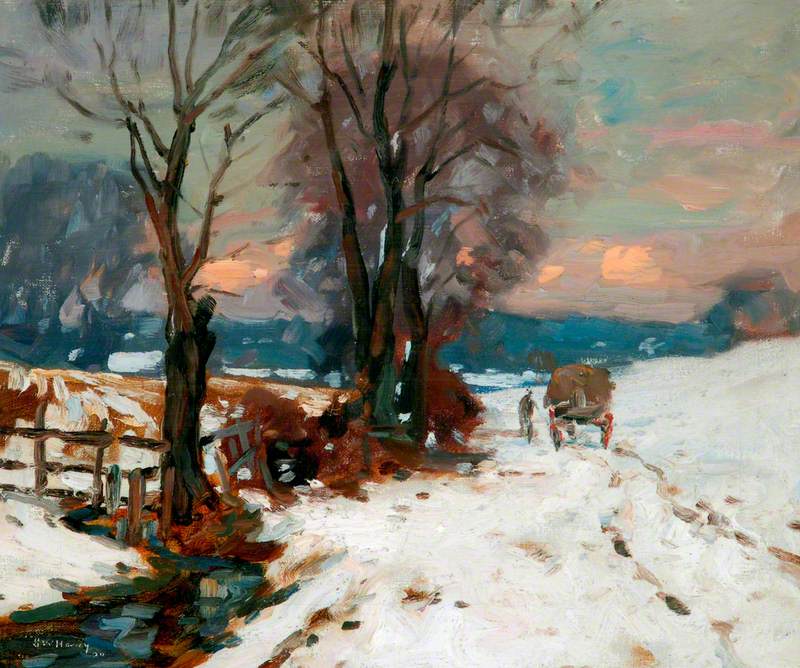 John William Howey (1873–1938)
John William Howey (1873–1938) -
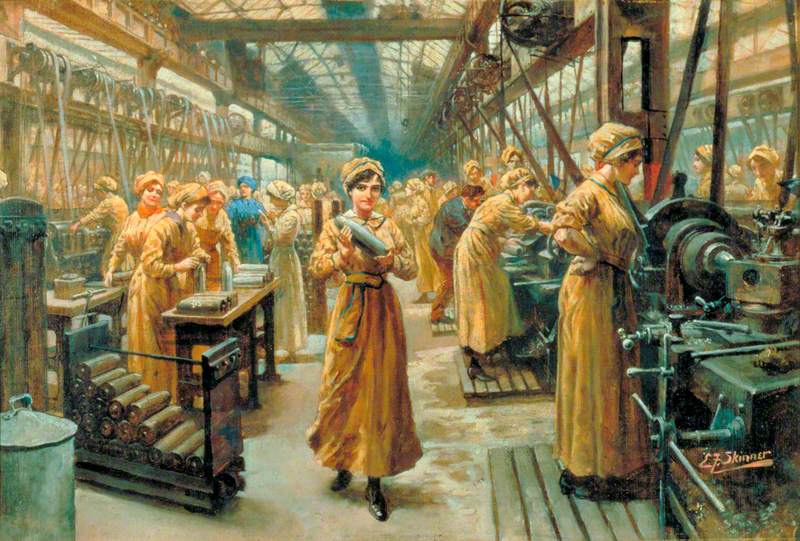 Edward Frederick Skinner (1865–1924)
Edward Frederick Skinner (1865–1924) -
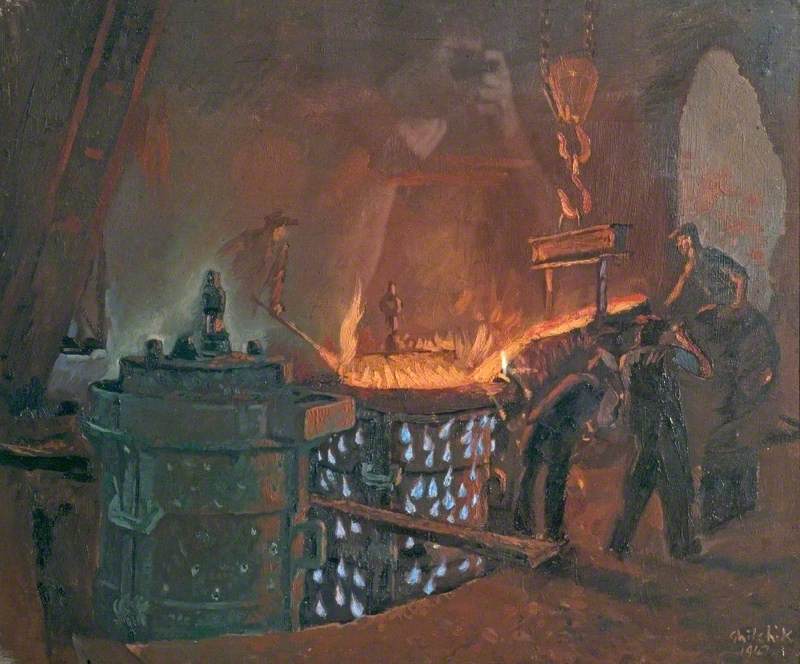 David Ghilchik (1890–1970)
David Ghilchik (1890–1970) -
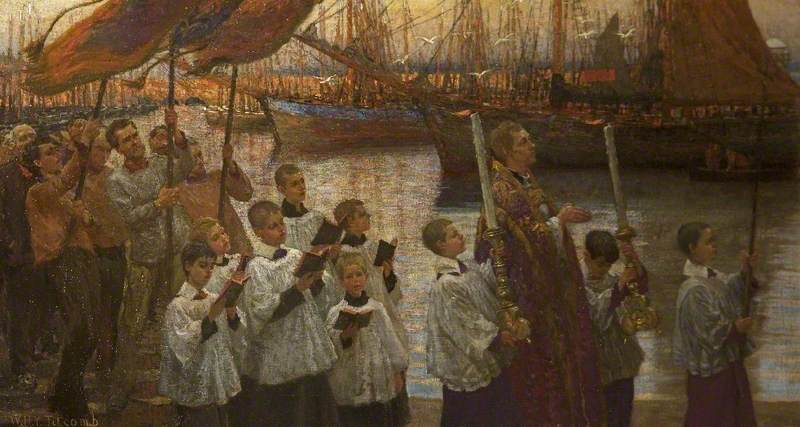 William Holt Yates Titcomb (1858–1930)
William Holt Yates Titcomb (1858–1930) -
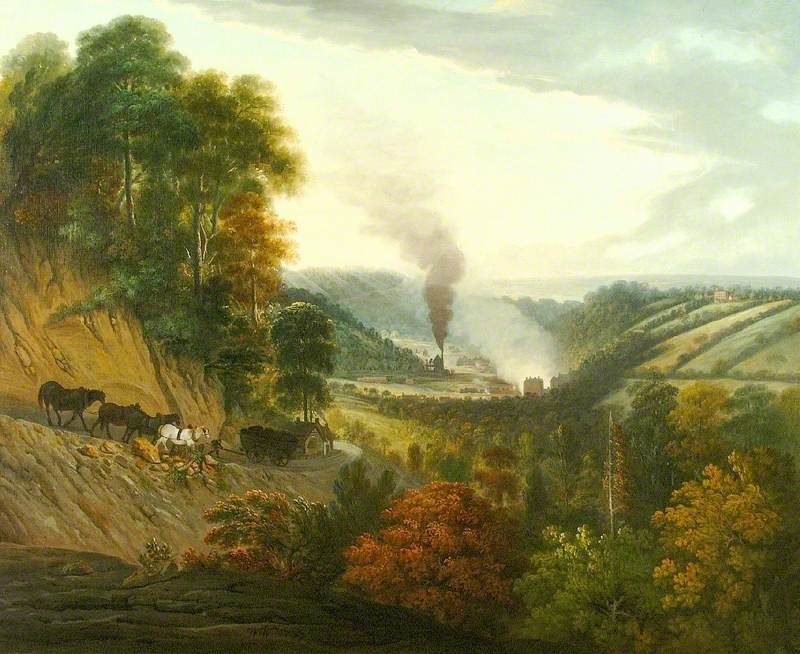 William Williams of Norwich (1727–1797)
William Williams of Norwich (1727–1797) -
 Tony Evans (1920–2001)
Tony Evans (1920–2001) -
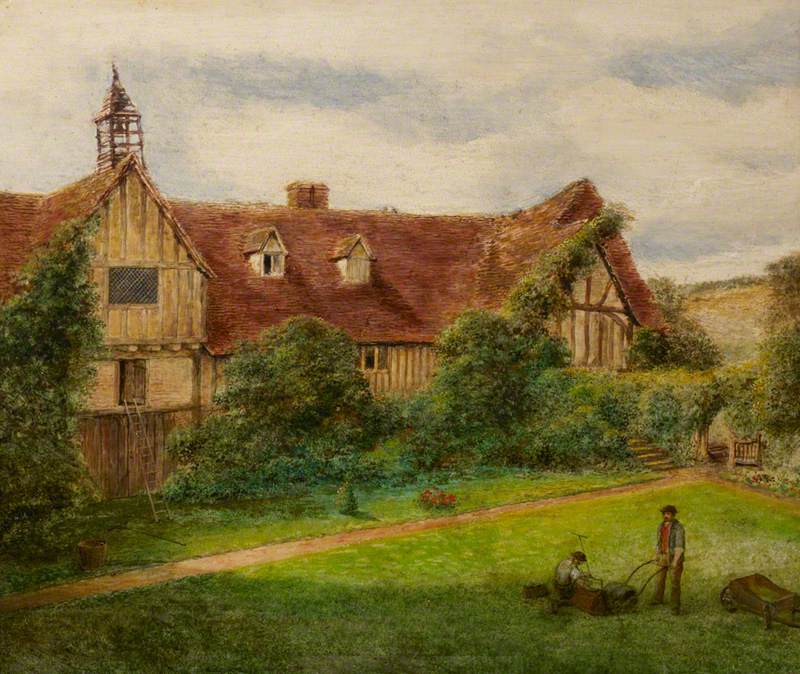 James Nasmyth (1808–1890)
James Nasmyth (1808–1890) -
 William Jones Chapman (1808–after 1870)
William Jones Chapman (1808–after 1870) -
 George Chapman (1908–1993)
George Chapman (1908–1993) -
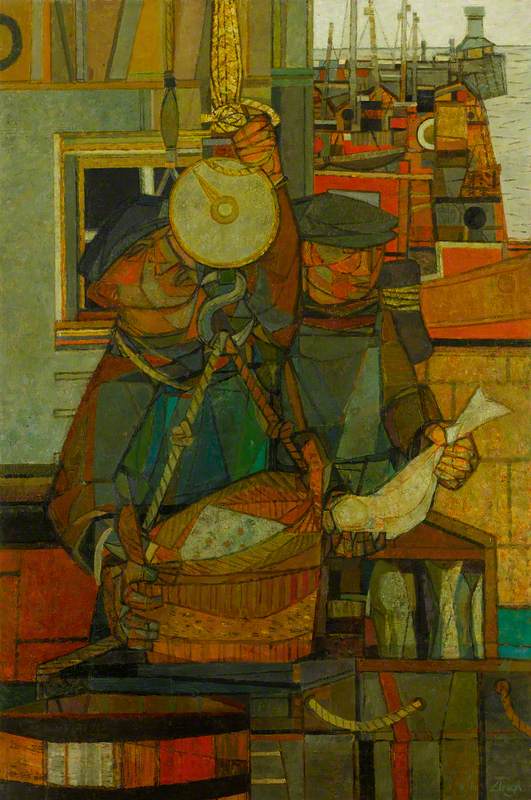 Prunella Clough (1919–1999)
Prunella Clough (1919–1999) - View all 44

